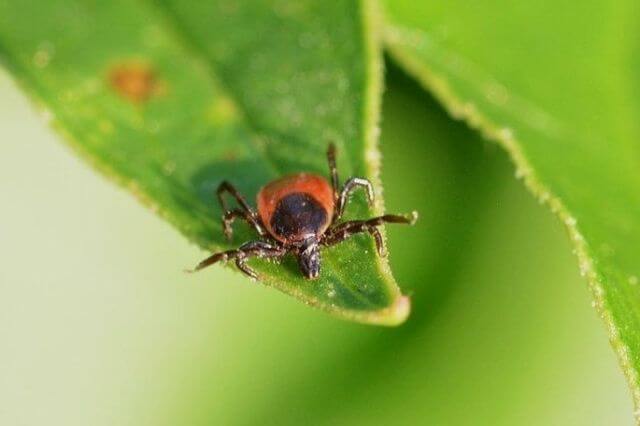There is a lot of false knowledge about ticks. Some have a little fact to it, others are just myths. You hear myths like ticks fall from trees onto their victims, only forest workers are at risk or ticks can be removed with glue.
True is: ticks can be quite dangerous because they can transmit dangerous diseases through their bite. The best tick protection is to know what’s true and to keep tick facts and myths apart.
To be able to protect yourself effectively against ticks and thus reduce the risk of tick-borne diseases, it helps to know as much as possible about ticks, their life and behavior, how to ward them off, and what to do if you are bitten.
Tick Facts And Myths
Ticks are active only in summer
- Unfortunately, ticks are NOT only active in summer. They become active when the temperature rises above 42 degrees Fahrenheit (7 degrees Celsius). Because of climate change and winter becoming milder and shorter, the period of tick activity is also increasing. In some regions, there is already tick activity throughout the year.
Ticks fall from trees
- Do ticks fall from trees? People ask that a lot, but it is just another myth that ticks fall from trees onto their victims when in range. No ticks do NOT fall from trees. Ticks sit on the ground, on grass, leaves, in bushes and undergrowth. Usually no more than 2 feet off the ground. Here they wait for warm-blooded animals or humans. In passing, the tick gets brushed off and transfers to the host.
Ticks are only a problem for rangers and forest workers
- They are NOT. Ticks have already conquered the cities. They hitch rides on their hosts which can be anything from mice, hedgehogs, birds, foxes to humans. They fall off their host when full of blood and may lay eggs even when they are in our yard or around the house. Outdoor activities are popular, so people are at risk when spending time gardening, camping, hiking or just being in nature.
The right clothing is enough protection
- The right clothing and the correct wear (pants in the socks) may make it a bit harder for ticks to find a good place to bite. Also giving you a bit more time to find and remove the tick before it has settled to their blood meal. White clothing helps to find them. But there is no 100% protection against ticks, clothing alone can NOT afford safe protection. In addition to the right clothing, repellents help to protect against the risk of tick-borne ticks.
Nail polish remover, glue, alcohol are great to remove ticks
- Do NOT use glue or oil! Similarly, burning the tick with a cigarette is not a good idea. If one kills the tick as long as it is still attached and feeds on its blood meal, it may vomit in its death struggle and delivers viruses and bacteria into the wound.
Always remove ticks correctly. Use pointed tweezers, a tick card, or a tick hook. Place this close to the skin possibly between the tick’s head and body. Move back and forth a little to loosen the barb of the ticks mouths. Then pull them out. If you do not have a special tick removal tool, carefully grasp the tick between your fingernails (do not squash them) and pull them out of the skin vertically. Clean and disinfect the wound.
A repellent on the naked skin is enough
- A tick repellent is either supposed to repel a tick so that it does not bite or is intended to kill the tick, depending on the product used. There are many chemical products as well as natural repellents to chose from. However, it is NOT enough to only rely entirely on a topical repellent as tick protection, as ticks can cling to clothing and slowly crawl up until they find a place to bite. For better protection spray your clothes to at least knee height. Better even wear tick repellent clothing when outdoors.
You can get vaccinated against ticks
- Unfortunately, you can NOT get vaccinated against ticks. There is only a TBE vaccination that protects against Tick-borne encephalitis, a tick-transmitted disease that is common in parts of Central and Eastern Europe, and Northern Asia.
Borreliosis can always be recognized by a red migrating skin spot
- The myth says that when a tick bite shows a red spot, one would be infected with borreliosis (Lyme disease). There are however many more conditions associated with red spots and the absence of a red spot around the tick bite does NOT mean that you have been spared from borreliosis. The so-called “migrans“ does not occur in all infections with borreliosis.
Ticks transmit only borreliosis and TBE
- Unfortunately, diseases spread by ticks are NOT confined to borreliosis and or TBE. Until today, there are at least 16 known illnesses that ticks may transmit to humans. Those tick-transmitted diseases are caused by various types of bacteria, viruses, and protozoa. A tick bite may cause more than one disease. There could be a whole cocktail of bacteria in a single tick’s intestines.
Learn more about ticks on this website and know how to hold tick facts and myths apart. Those little spidery creatures must not be underestimated as their bites can have serious consequences on your health. It is important to observe the bite and monitor yourself for symptoms, so you know when to worry about a tick bite.
If symptoms occur after a tick bite, a doctor should immediately be consulted. A fast diagnosis and treatment can prevent severe progression and late effects or at least reduce the risk.



